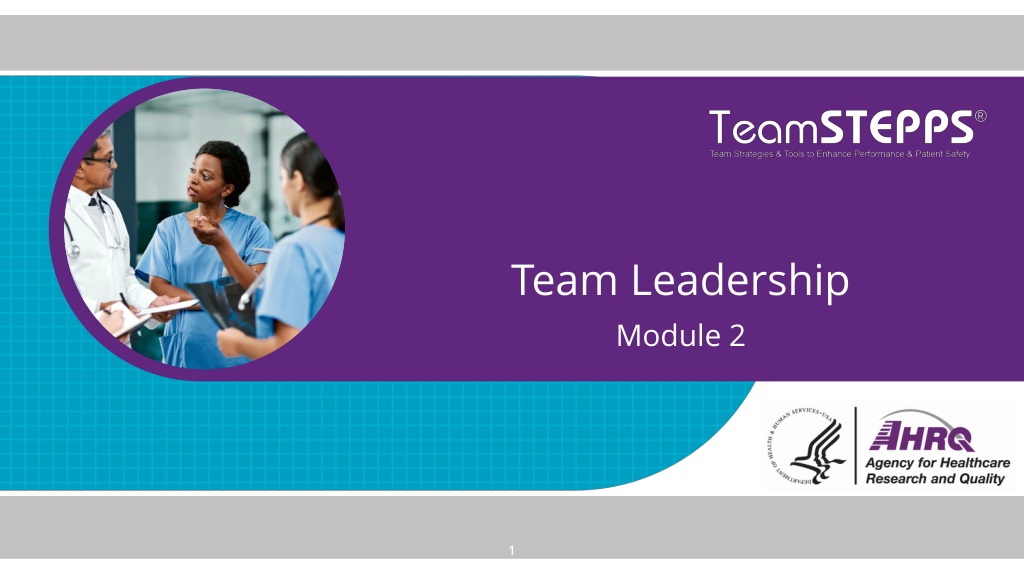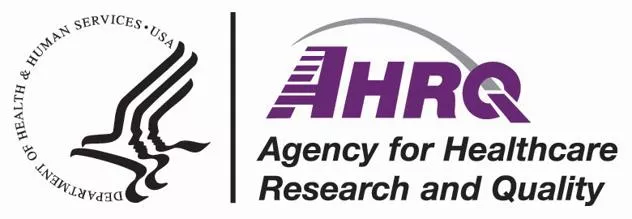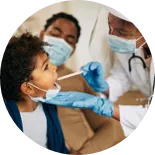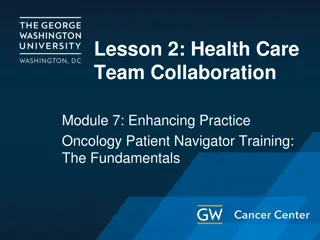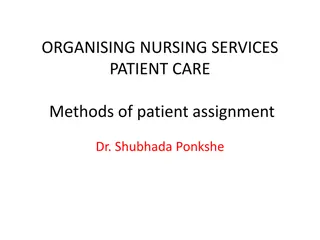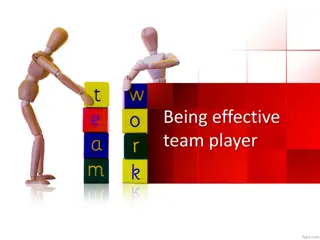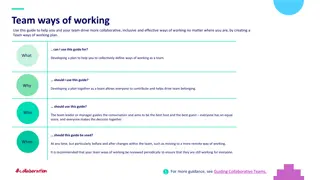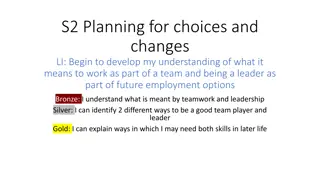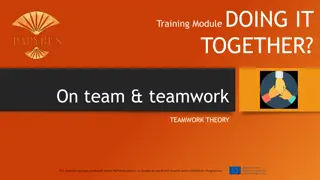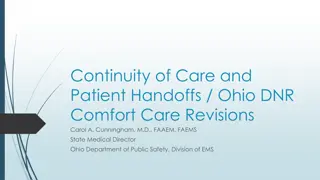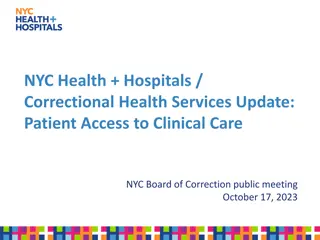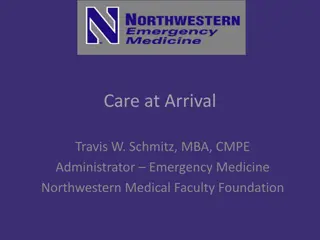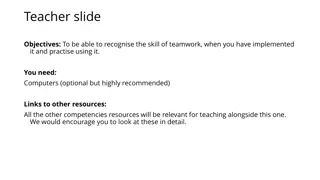Effective Team Leadership for Patient Care Collaboration 2.Summary: Understanding the importance of teamwork structures, roles, and interactions within healthcare settings is crucial for successful patient care. This module highlights the benefits o
Team Leadership, Patient Care, Healthcare Teams, Collaboration, Patient Engagement
Download Presentation

Please find below an Image/Link to download the presentation.
The content on the website is provided AS IS for your information and personal use only. It may not be sold, licensed, or shared on other websites without obtaining consent from the author. Download presentation by click this link. If you encounter any issues during the download, it is possible that the publisher has removed the file from their server.
E N D
Presentation Transcript
Team Leadership Module 2 1
Understanding Teams and Team Structure 2
Team Leadership Objectives: Team Structure Understand the benefits of teamwork and clear team structure. Define a team. Identify the roles of patients and family caregivers within the care team. Describe the components and composition of a multi-team system. 3
Team Leadership Team Structure Teamwork cannot occur in the absence of a clearly defined team. Understanding a team s structure and how multiple teams interact is critical for implementation planning. 4
Team Leadership What Defines a Team? Two or more people who interact dynamically, interdependently, and adaptively toward a common and valued goal, have specific roles or functions, and have a time-limited membership Teams can be: In-person or virtual. Temporary or permanent. Frequently changing due to staff schedules and assignments. 5
Team Leadership Team Exercise Identify a patient type that you frequently support. List all the people (names or positions) responsible for directly or indirectly supporting the care of this patient. Are they all on one team or parts of separate teams supporting the patient? Report out on your conclusions. 6
Team Leadership Partnering With the Patient Patients are members of the core team; a family caregiver may also be. Strategies for involving patients and family caregivers in teams: Include patients in bedside rounds. Conduct handoffs at the patient s bedside. Provide patients and family caregivers with tools for communicating with their care team (e.g., phone numbers, email, patient portal). Involve patients on key committees. Actively encourage patient and family caregiver participation. 7
How Teams Can Foster Patient and Family Caregiver Involvement Team Leadership Embrace patients and family caregivers as separate, valuable, and contributing partners: Listen and elicit feedback from both patients and family caregivers. Assess patients preference regarding involvement. Ask patients about their concerns. Speak to them in lay terms. Allow time for patients and family caregivers to ask questions. Treat patients and family caregivers as distinct, with different information, preferences, and concerns. Help them access relevant information on a patient portal. 8
Patients and Family Caregivers Can Function Effectively in Their Teams by: Team Leadership Providing accurate patient information. Collaborating to create a care plan that they will follow (e.g., taking medications, scheduling and attending appointments). Asking questions and voicing any concerns regarding their care. Monitoring and reporting changes in the patient s condition. Coordinating and communicating with other family members. Encouraging and showing appreciation to other team members. 9
Multi-Team System (MTS) for Patient Care Team Leadership 10
Team Leadership A Core Team Is A group of care providers who work interdependently to manage a set of assigned patients from point of assessment to disposition. Core Team members have the closest contact with the patient. 11
Team Leadership A Contingency Team Is A time-limited team formed for emergent or specific events and composed of members from various teams. 12
Team Leadership A Coordinating Team Is A team comprising those work area members who are responsible for managing the operational environment that supports the Core Team. 13
Team Leadership Ancillary and Support Services Ancillary Services provide direct, task-specific, time-limited care to patients. Support Services provide indirect service-focused tasks that help facilitate the optimal healthcare experience for patients and their families. 14
Team Leadership The Role of Administration Is To Establish and communicate vision. Develop policies and set expectations for staff related to teamwork. Support and encourage staff during implementation and culture change. Hold teams accountable for team performance. Define the culture of the organization. 15
Team Leadership Team Structure Video 16
Team Leadership Team Structure Discussion What types of teams were involved in the scenario? Where did the breakdowns occur between the components of this multi-team system? What could the individuals involved in this scenario have done differently to produce a better outcome? 17
Team Leadership Applying TeamSTEPPS Exercise 1. Who are the members of the team experiencing a teamwork issue? 2. Which team or teams within your multi-team system are experiencing the teamwork issue? Which team or teams interact with or are otherwise affected by the team(s) experiencing the issue? 18
Team Leadership Exercise: Leadership Instructions: Begin by selecting a leader and scribe for your group. Create two lists: What makes an effective team leader? What makes a team leader ineffective? Be prepared to report your answers out to the entire group. 20
Team Leadership Objectives Describe how leadership affects team processes and outcomes. Identify different types of team leaders. Describe the activities involved in successfully leading teams. Describe the tools for leading teams, including briefs, huddles, and debriefs. Apply the tools for leading teams to specific clinical scenarios. 21
Team Leadership Leadership Ensures the patient remains the focus for all team decisions Holds a teamwork system together Ensures a plan is conveyed, reviewed, and updated Is facilitated by communicating, continuously monitoring the situation, and fostering an environment of mutual support 22
Team Leadership Types of Team Leaders Designated: The person assigned to lead and organize a team, establish clear goals, and facilitate open communication and teamwork among team members Situational: Any team member with the skills to manage the situation at hand 23
Team Leadership Effective Team Leaders Ensure the patient s needs and preferences are understood and prioritized. Define, assign, share, monitor, and modify a plan. Review the team s performance. Establish rules of engagement. Manage and allocate resources effectively. Provide feedback regarding assigned responsibilities and progress toward the goal. Facilitate information sharing. Encourage team members to assist one another. Facilitate conflict resolution. Model effective teamwork. 24
Team Leadership Defining the Plan When developing a plan, team leaders should consider: Patient: What does the patient need and how can the team best provide it? Time: How much time is available to complete all the necessary tasks and activities? People: Do available staff have the necessary knowledge and skills to perform their roles? Equipment: Is the needed equipment available and working? Information: Has all the needed information been collected and reviewed? 25
Team Leadership Case Study Discussion After attending TeamSTEPPS Master Training, a physician and nurse leader in a Level I Trauma Center decide that trauma resuscitations could be conducted more effectively. Currently, when a trauma alert is called to indicate the pending arrival of a severely injured patient, more staff show up to the trauma bay than needed, necessary equipment is sometimes missing or not functioning properly, and the lead trauma physician often shows up just as EMS is bringing the patient into the trauma bay. You observe that these practices have led to confusion that puts patients at risk and results in valuable time being lost. How can principles of effective leadership and planning guide what you should do? 26
Assigning Tasks and Responsibilities Team Leadership Determine the tasks and roles to be assigned. Determine which roles must be filled and allocate tasks appropriately. Communicate clear expectations of what team members need to do. Request feedback. 27
Team Leadership Sharing the Plan: Briefs A team brief is an effective strategy for sharing the plan. Briefs should help: Form the team. Designate team roles and responsibilities. Establish climate and goals. Engage team in short- and long-term planning. How did the video illustrate each recommended phase of a team brief? Which elements of the brief are most commonly omitted in teams you are part of? 28
Team Leadership Brief Checklist Tool 29
Team Leadership Exercise: Brief Instructions: 1. In your small group, identify a type of healthcare team everyone in the group can relate to. 2. For this team, identify when, why, and where briefs might be conducted. Note who should lead the brief and who should participate. 3. List up to four items you would include on a checklist for one of the briefs you ve identified. 4. Discuss what outcomes you expect to see as a result of implementing briefs. 5. At the end of the exercise, present and discuss your plans with the class. 30
Monitoring and Modifying the Plan: Huddle Team Leadership Problem solving: Hold ad hoc, touch base meetings to regain situation awareness. Discuss critical issues and emerging events. Anticipate outcomes and likely contingencies. Assign resources. Express concerns. Elicit input and answer patient questions when appropriate. How did the video illustrate the effective use of a huddle? What one change would make huddles of your team more effective? 31
Reviewing the Teams Performance: Debrief Team Leadership Debriefs foster process improvement: Brief, informal information exchange and feedback sessions Occur after an event or shift Designed to improve teamwork skills Designed to improve outcomes: An accurate recounting of key events Analysis of why the event occurred Discussion of lessons learned and reinforcement of successes Revised plan to incorporate lessons learned 32
Team Leadership Debrief Video Why is it important to debrief after processes that went well AND those that didn t? What made this debrief effective and what might have made it even better? What one change would make debriefs in your team work more effectively? 33
Team Leadership Facilitating Conflict Resolution Effective leaders: Facilitate conflict resolution to avoid compromising patient safety and quality of care. Do not allow interpersonal or irrelevant issues to negatively affect the team. Help team members master conflict resolution techniques. 34
Promoting and Modeling Teamwork Team Leadership Effective leaders cultivate desired team behaviors and skills through: Open sharing of information. Role modeling and effective cuing of team members to use prescribed teamwork behaviors and skills. Constructive and timely feedback. Facilitation of briefs, huddles, debriefs, and conflict resolution. Mitigation of conflict within the team. 35
Team Leadership Team Leadership Video What leadership tools and strategies were used by Drs. Dean and Upton? How did the nurses demonstrate leadership? 36
Team Leadership Tools and Strategies Summary 37
Team Leadership Applying TeamSTEPPS Exercise 1. Who is the designated leader on the team that is at the center of your TeamSTEPPS implementation? 2. Do you have teamwork issues that this leader must work with you to address? 3. If so, what are the issues and can any of the tools or strategies learned in this module be used to address them? 38
